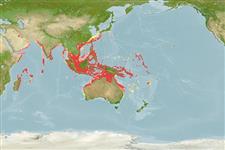>
Eupercaria/misc (Various families in series Eupercaria) >
Lutjanidae (Snappers) > Lutjaninae
Etymology: Lutjanus: Malay, ikan lutjan, name of a fish.
More on author: Bloch.
Environment: milieu / climate zone / depth range / distribution range
экология
морской ассоциированный с рифами; пределы глубины 5 - 100 m (Ref. 55). Tropical; 34°N - 35°S, 47°E - 180°E (Ref. 55)
Indo-West Pacific: Persian Gulf and Gulf of Oman to Fiji, north to southern Japan and Jeju Island, Korea (Ref. 114833), south to New South Wales, Australia (Ref. 114833) and New Caledonia (Ref. 86942). This species has been referred to as Lutjanus malabaricus (non Schneider) or Lutjanus altifrontalis by many recent authors. Occurrence in the Red Sea is a misidentification (Ref. 84159).
Length at first maturity / Size / Вес / Возраст
Maturity: Lm 50.2, range 50 - ? cm
Max length : 81.6 cm FL самец/пол неопределен; (Ref. 5739); common length : 45.0 cm TL самец/пол неопределен; (Ref. 55); наибольший возраст (опубликованны данные): 8 годы (Ref. 5739)
колючие лучи спинного плавника (общее число) : 11; членистые (мягкие) лучи спинного плавника (общее число) : 12 - 14; колючие лучи анального плавника: 3; членистые (мягкие) лучи анального плавника: 8 - 9. Deep-bodied. Dorsal profile of head sloped. Length of upper jaw smaller than distance bet. base of last dorsal and anal rays. Preorbital bone usually narrower than eye diameter. Preopercular notch and knob poorly developed. Scale rows on back rising obliquely above lateral line. Juveniles with an oblique band extending from mouth to beginning of dorsal fin and a black spot at the caudal peduncle (Ref. 469). Body depth 2.5-3.0 in SL (Ref. 90102).
Adults inhabit trawling grounds and reefs. They are present over shoals, rubble, corals, large epibenthos, hard or sandy mud substrates and offshore reefs (Ref. 6390). Usually in groups (Ref. 90102). Juveniles from about 2.5 cm length inhabit shallow waters over muddy substrates (Ref. 6390). Feed on a broad range of prey dominated by fish, and with small amounts of crustaceans, cephalopods and other benthic invertebrates (Ref. 6390). They forage mostly at night (Ref. 6390). They are marketed either gilled and gutted, whole as fillets, as fresh chilled or frozen product (Ref. 6390).
Are serial batch spawners (Ref. 6390).
Allen, G.R., 1985. FAO Species Catalogue. Vol. 6. Snappers of the world. An annotated and illustrated catalogue of lutjanid species known to date. FAO Fish. Synop. 125(6):208 p. Rome: FAO. (Ref. 55)
Статус Красного Списка МСОП (Ref. 130435)
Угроза для людей
Harmless
Использование человеком
рыболовство: коммерческий; аквакультура (рыбоводство): коммерческий
дополнительная информация
инструменты
Специальные отчеты
Скачать в формате XML
ресурсы в Интернет
Estimates based on models
Preferred temperature (Ref.
123201): 25.3 - 29.1, mean 28.2 °C (based on 1590 cells).
Phylogenetic diversity index (Ref.
82804): PD
50 = 0.5000 [Uniqueness, from 0.5 = low to 2.0 = high].
Bayesian length-weight: a=0.01514 (0.00776 - 0.02952), b=2.96 (2.80 - 3.12), in cm total length, based on LWR estimates for this species & Genus-body shape (Ref.
93245).
Trophic level (Ref.
69278): 4.5 ±0.7 se; based on diet studies.
устойчивость к внешним воздействиям (Ref.
120179): средний (среднего размера), минимальное время удвоения популяции 1.4-4.4 года (K=0.21-0.39; tm=4; tmax=8; Fec=5 million).
Prior r = 0.66, 95% CL = 0.43 - 0.99, Based on 1 data-limited stock assessment.
Fishing Vulnerability (Ref.
59153): Moderate vulnerability (42 of 100).
Nutrients (Ref.
124155): Calcium = 25.7 [15.5, 39.1] mg/100g; Iron = 0.342 [0.214, 0.558] mg/100g; Protein = 18.7 [17.2, 20.1] %; Omega3 = 0.136 [0.091, 0.202] g/100g; Selenium = 73.1 [45.4, 124.1] μg/100g; VitaminA = 154 [31, 621] μg/100g; Zinc = 0.308 [0.236, 0.442] mg/100g (wet weight);
